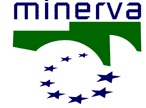| |
Identification of user needs, content and quality framework for common access
points Working group
|
 |
1° MINERVA Workshop
Knowledge Representation in the semantic cultural web
The seminar “Knowledge representation in the semantic cultural
web” organized in Rome, 6 July 2004 in Palazzo Massimo,
(Largo Peretti 1), is the first initiative coordinated by the
Italian WG5 of the MINERVA project, in collaboration with W3C
Italian office, in order to delineate the context of the semantic
web and ontologies applied to cultural heritage. The Italian WG5
has committed itself in this field of research, creating and internal
study committee on ‘Ontologies for cultural heritage’
headed by Oreste Signore. The object is to create a meeting point
of experiences and diffusion of knowledge attained in this field.
The results of the study committee will be presented at the Convention
organized by MINERVA and the Italian Ministry of Culture that
will take place in Venice in November 2004.
The seminar was articulated in four parts:
- General framework, in which the themes and problems created
by the application of ontologies in the sector of cultural heritage.
Made contributions: Rossella Caffo (Head of the Minerva Project,
Manager Service VI MiBAC), Fedora Filippi (Coordinator, Minerva
project Italian WG5, Archaeologist of the Soprintendenza Archeologica
di Roma), Oreste Signore (ISTI-CNR and W3C Office in Italy)
Nicola Guarino (Laboratory of Applied Ontology of the ISTC-CNR)
- The International context in which on-going projects have
been presented, like the CIDOC CRM (a proposal for a Conceptual
Reference Model fostered by the International Committee for
Documentation of the International Council of Museums. It has
the form of an object–oriented domain ontology for the
interchange of rich and heterogeneous cultural heritage information
from museums, libraries and archives and its purpose is to provide
a building block for supporting the development of a global
Semantic Cultural Web) and the development of ontologies carried
out by the re-engineering of dictionaries, thesauri, controlled
dictionaries, such as, for example, the Art and Architecture
Thesaurus or the Cultural Heritage Thesaurus of the British
Museum, obtained by extracting simple ontologies from texts.
Made contributions: Oleg Missikoff (CeRSI-LUISS) and Aldo Gangemi
(Laboratori of Appplied Ontology of the ISTC-CNR)
- Experiences and projects, in which some results obtained
in the field of Italian research were presented: In particular
Paola Moscati (Istituto di Studi sulle Civiltà Italiche
e del Mediterraneo Antico – CNR) presented the work carried
out by ISCIMA of the CNR for the codification of non structured
archaeological documents for the creation of a model of on-line
archiving, management and consultation of data concerning archaeological
research carried out in Etruria and the Sabina tiberina, which
emphasised the use of Metadata for ontology, research, and communication
in archaeology.
Marco Berni (Institute and Museum of the History of Science
of Florence) described the work on ontologies carried out by
the Institute and Museum of the History of Science of Florence
initiated with the European Project MESMUSES.
The Project BRICKS (Building Resources for Integrated Cultural
Knowledge Services) has among its objectives the creation of
the technological and organisational foundations of a ‘Digital
Library’ in the ambit of the European Digital Memory.
An on-line system of services on completely available collections
of digital documents will be set up, providing diverse levels
of information according to the user profile and access modalities.
Francesco Nucci of Engineering Roma, partner in the Project,
described the Bricks approach to ontologies: emerging semantics.
Great attention will be dedicated to the semantic web standard
(like RDF(S), OWL), working in collaboration with the Minerva
Project. BRICKS will use many onthologies to describe specific
Cultural Contents. At the same time BRICKS aims to manage different
agreements between different onthologies In this way it will
be possible to create areas of co-operation. These areas will
co-operate with each other to share contents and services.
Paola Velardi (teacher within the Dipartimento di Informatica
- Università di Roma ‘La Sapienza’) presented
OntoLearn, a methodology and a battery of software tools that
use text mining and statistical techniques to construct a domain
ontology for automatic semantic annotation.
- Future Prospects. The day concluded with the presentation
of Oreste Signore which traced the lines for the development
of ‘A reference model for the semantic cultural web’.
In particular, Signore indicated the problem of semantic interoperability
as an important aspect in the domain of representing knowledge
of cultural heritage. The complexity is made up by the harmonization
of the descriptive screens and the ontologies, two tightly connected
aspects. In fact, one has keep in mind that the organisation
of the concepts (ontological aspect) cannot be separate from
or unrelated to the scheme adopted to represent the information.
In other words, the complexity deriving, for example, from the
specialisation of the objects by function or type (e.g. flying
buttress, ointment jar, spiral column) must necessarily find
place in a classification system (thesaurus) or in the articulation
of the descriptive card (namely sector, sub-sector, characteristic).
It therefore follows that the semantic interoperability among
collections cannot be faced by simply finding equivalent terms,
not an easy task in itself, but must take into account how a
determinate organisation of concepts can be translated towards
a specific plan of representation.
In the ambit of the Italian WG5’s activity experiments
on the material of current projects will be carried out.
To view the programme, the abstracts and the presentations consult
W3C website at the address http://www.w3c.it/events/minerva20040706/index.html
|
|
|

